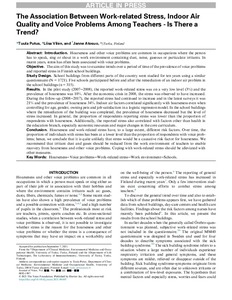The Association Between Work-related Stress, Indoor Air Quality and Voice Problems Among Teachers - Is There a Trend?
Putus Tuula; Vilén Liisa; Atosuo Janne
https://urn.fi/URN:NBN:fi-fe2021120158442
Tiivistelmä
Introduction
Hoarseness and other voice problems are common in occupations where the person has to speak, sing or shout in a work environment containing dust, noise, gaseous or particulate irritants. In recent years, stress has often been associated with voice problems.
Objective
The aim of this study was to examine trends over a period of time of the prevalence of voice problems and reported stress in Finnish school buildings.
Study Design
School buildings from different parts of the country were studied for ten years using a similar questionnaire (N = 1721). Five schools participated before and after the remediation of an indoor air problem in the school buildings (n = 315).
Results
In the pilot study (2007–2008), the reported work-related stress was on a very low level (3%) and the prevalence of hoarseness was 10%. After the economic crisis in 2008, the stress was observed to have increased. During the follow-up (2008–2017), the reported stress had continued to increase and in the latest surveys it was 21% and the prevalence of hoarseness 34%. Indoor air factors correlated significantly with hoarseness even when controlling for age, gender, owning pets and job satisfaction in a logistic regression model. In the school buildings where the remediation of the building was completed, the prevalence of hoarseness decreased but the level of stress increased. In general, the proportion of respondents reporting stress was lower than the proportion of respondents with hoarseness. Additionally, the reported stress also correlated with factors other than health in the education branch, especially economic resources and major changes in the core curriculum.
Conclusion
Hoarseness and work-related stress have, to a large extent, different risk factors. Over time, the proportion of individuals with stress has been at a lower level than the proportion of respondents with voice problems; hence, we conclude that it is quite unlikely that stress would be a causative risk factor for hoarseness. We recommend that irritant dust and gases should be reduced from the work environment of teachers to enable recovery from hoarseness and other voice problems. Coping with work-related stress should be alleviated with other measures.
Kokoelmat
- Rinnakkaistallenteet [27094]
